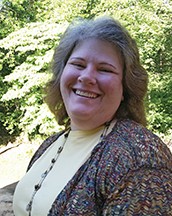Depressing Short Winter Days
 By Grace R. Denault, BA, RPSGT, RST, CCSH
By Grace R. Denault, BA, RPSGT, RST, CCSH
In Delaware, the shortest day of the year is over 5½ hours shorter than the longest day of the year. Many think the shorter days sap their energy and depress their mood. They are right! Changes in light exposure has been proven to effect mood, concentration and energy.
Human daily rhythms are controlled by two internal timekeeping systems. The homeostatic system keeps track of how long you have been awake; the longer you’ve been awake, the more you will need to sleep. This system is independent of light and dark. The other system is the circadian system. It keeps track whether it is day or night; it makes you want to sleep during the night and makes you alert during the day. You have an internal timer tracking day and night, but it is inexact. Fortunately, that timer is reinforced by daylight. Essentially, sunlight resets the circadian timer every day.
Normally the homeostatic and circadian systems are in sync with each other and with our daily lives. There are circumstances, however where they become out of sync, like working night shifts, for example. Despite the fact you were yearning for sleep through your night shift, you might struggle to fall asleep after you get home because it’s daytime. Your homeostatic drive wants you to sleep because you’ve been up all night, but your circadian timer wants you to be alert because it’s daytime and the sun is up.
Our bodies have many, many systems that function as daily rhythms, from body temperature to appetite to hormone patterns and more. The coordination of all these systems depends on the circadian timer to keep them in tune with each other. When the homeostatic and circadian systems get weak or out of sync, these various systems lose their synchronization and we feel it – in a bad way. It affects concentration, mood, appetite, energy level and more.
As the days get shorter in winter, the sun does not reset the circadian timer as strongly as it does in other seasons. Some people are sensitive enough that this weakening of reinforcement from the sun can allow their circadian timekeeper to become unsteady. They start to show signs of this desynchronization: concentration dwindles, mood turns blue, appetite increases (especially for carbohydrates) and alertness sinks.
For some folks, they feel “out of sorts” and perhaps a little of the “winter blues” or “winter doldrums.” Others are so sensitive to this effect that they suffer clinical levels of depression in the winter – a phenomenon called Seasonal Affective Disorder (SAD). The degree of depression these folks suffer is significantly beyond feeling “out of sorts.” Both the “winter blues” and SAD resolve with the longer days of spring or summer and return the following fall or winter as the days shorten again. If you think you may suffer from SAD, make sure to discuss with a medical professional who specializes in this area.
There are some easy steps you can take on your own to combat the winter blues. Get as much morning light as you can. Even a few minutes outside soon after you get up can help reset the circadian rhythm. If morning sunlight isn’t doing enough for you, consider bright light therapy lamps or full spectrum lamps. There are even versions that are shaped like eyeglasses. Blue and green wavelengths of light are especially effective on circadian rhythms. Try to get 30-120 minutes of light exposure every morning.
Daily exercise, but not too close to bedtime, will also help to reinforce your cortisol and body temperature circadian rhythms. Daily exercise outside in the morning will have the most significant effect because of the added benefit of morning sunlight.
You need to be careful with evening activities as well. Minimize light in the evenings, especially blue and green light. Many people are not aware how much blue light our electronics emit. Computers, tablets, phones and televisions all emit enough blue light to flatten our circadian rhythms. More and more devices now have settings to limit the blue light emitted at night. If your device has that feature, turn it on. If it does not, try to use these devices earlier in the day and reserve the evening for non-electronic entertainment or activities. If you sleep with the tv on, do your best to break that habit.
Some find taking melatonin supplements in the evening will also help. This makes sense because one of the strongest daily rhythms controlled by the circadian timer is melatonin output. It is also among the systems most sensitive to light exposure. Just a few minutes of light in the middle of the night can decrease melatonin output for the rest of the night.
All of these steps can help you combat the winter blues. If you feel your symptoms are stronger and may be more than winter blues, make sure to see a doctor or psychologist. Those with specialized training in sleep disorders will have the expertise to help with issues like circadian rhythm disorders and Seasonal Affective Disorder.
About the author:
Ms. Denault has been involved with Sleep Medicine for almost 3 decades. She obtained her B.A. in Psychology from Johns Hopkins University in 1988.
She holds Registered Polysomnographic Technologist (RPSGT) credential #720 (there are currently more 17,000). In addition to her RPSGT, she also received the Registered Sleep Technologist (RST) credential during its inaugural year and Certification in Clinical Sleep Health in 2017.
Her experience in sleep medicine includes front-line patient care, management, research, education and legislative activities. She has worked on item development for national sleep technologist exams.
Ms. Denault has been Secretary and President of the Delaware Sleep Society and was instrumental in shepherding the Delaware Professional Polysomnographer act into law.
Ms. Denault holds the first Professional Polysomnographer license ever issued in the state of Delaware and she is a member of the Polysomnography Advisory Council to the Delaware Board of Medical Licensure and Discipline.
Ms. Denault is an instructor at Delaware Technical and Community College and at University of Delaware Professional and Continuing Studies, teaching courses related to Sleep Medicine. Ms. Denault is available to work with firms to improve protocols and facilities to increase safety and productivity from an alertness and circadian rhythms perspective. She also enjoys working with community groups as a speaker on sleep medicine topics. Ms. Denault will be coordinating the Sip and Sleep Conference for medical professionals at Nassau Valley Winery on March 9th. Please see www.academysleepwellness.com for details.
Delaware Sleep Disorder Centers, LLC, is staffed and equipped to evaluate and treat most sleep-related disorders. Diagnosis and treatment for many disorders may begin after just one night. When performing a sleep study, our technologists work closely with our medical director – (a physician who is board certified in Sleep Medicine, Pulmonary Medicine or Neurology) – to identify and confirm sleep disorders, measure their severity and recommend multiple treatment options.
Locations:
Sandhill Medical 118 Sandhill Drive Suite 201 Middletown, DE 19709
701 Foulk Rd. Suite 1G Wilmington, DE 19803
Connor Building @ Springside Plaza 300 Biddle Ave Suite 102 Newark, DE 19702
Medical Arts Bldg., Beebe Health Campus 18947 John J. Williams Highway Suite 213 Rehoboth Beach, DE 19971
20930 North DuPont Boulevard Suite 202 Georgetown, DE 19947





